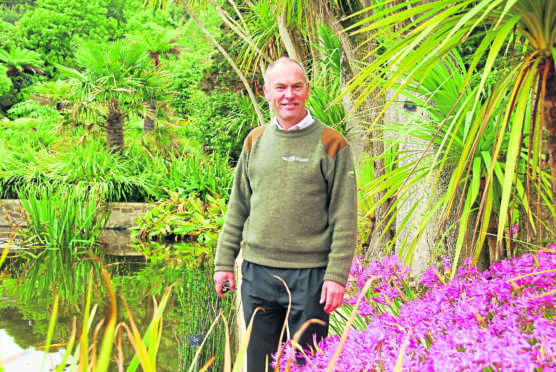
Visit any of the beautiful arboreta or botanic gardens around the country, and you will see flowering plants, shrubs and trees from all over the world.
Perhaps, however, we fail to consider the origins of the weird and wonderful species around us. As habitats shrink at a gut-wrenching rate, it becomes ever more critical to save the world’s rare plants. And while in-situ conservation is always the best option, the world’s leading botanic gardens provide a vital backup resource.
Richard Baines has an encyclopaedic knowledge of all things botanical and has helped shape some of the most exquisite gardens in the country, including Kew Royal Botanic Gardens in London.
It’s doubtful whether we appreciate the arduous journeys that are still made to safeguard endangered seed. Modern- day conservationists need to be fearless in the race to combat the climate emergency and biodiversity crisis. Their work is deserving of the highest accolades.
Richard has been curator of Logan Botanic Garden for over a decade. Described as Scotland’s most exotic, this paradise on the Mull of Galloway is part of the Royal Botanic Garden Edinburgh (RBGE), a world leader in plant science and conservation horticulture, working with partners in more than 35 countries to protect vulnerable habitats.
Massaged by the balm of the Gulf Stream, plant treasures from South and Central America, South Africa and Australasia thrive at Logan Botanic Garden. In a forthcoming book, Richard will reveal tales of his extraordinary fieldwork in Vietnam, discovering and retrieving such treasures.
Richard has a rare gift. He captivates an audience, seamlessly passing on knowledge and the minutiae of scientific jargon as if by osmosis. His enthusiasm is infectious, and his stories are liberally punctuated with humour and intrigue.
“I have always loved plants.” Richard says. “Some of my early memories involve pruning roses at home. My late father drove our family’s gardening passion. When I was a teenager, I cultivated over an acre of vegetables and maintained a large orchard.
“I always wanted to grow something new. I was fortunate to be brought up at Senwick House, a sheltered garden outside Kirkcudbright, famous for its millions of daffodils.”
Intrigued by the sense of exploration and discovery, it was in the 1970s, watching Roy Lancaster discussing his plant exploits in the Far East on Gardeners’ World that prepared the ground for Richard’s life of adventure.
Plant hunting is a laborious process, taking months, and even years, of planning with associates here and in the partner country to secure the necessary permissions to collect for conservation and acquire visas, guides, and supplies.
These are followed by long hours walking through treacherous terrain, often in steaming monsoon weather, sometimes at high altitudes. And after long, exhausting days, all the precious seed must be painstakingly dried and stored to avoid it rotting in the intense humidity.
The team must also acclimatise to eating any food that is available to them, miles from any kind of sophisticated eateries.
“You never know what you are going to eat. Food hygiene, or lack of it, must be ignored – it can be hard when a fizz of flies accompany dinner. I take a stash of chocolate bars and soup packets in case I cannot stomach the food. Climbing mountains uses so much energy, and it’s vitally important to keep up our strength.”
While a student at the Royal Botanic Gardens, Kew, Richard was awarded a scholarship to study plants in the Pontic Alps in Northern Turkey. He spent a month with Gerrard Henry, Kew’s Alpine supervisor looking for species to enrich the collection.
“We located Daphne glomerata that produces sweetly scented tubular flowers,” Richard says. “This important trip gave me an insight into the criteria for successful exploration, namely, flexibility, grasping opportunity, thorough research, talking to others beforehand, and considering potential perils such as washing in rivers where snakes swim past!”
The foundation of any botanic garden is based on the collection and documentation of wild origin plant material. Within the RBGE corporate plan, one of the objectives is to increase collections by 1% each year.
Guided by a plant collections policy each of Scotland’s four gardens – the Edinburgh Botanics, Dawyck, Benmore and Logan – has specialist plant groups depending on climate. For Logan, it is Australasia and New Zealand, South America, South Africa, the Atlantic Islands and, more recently, Northern Vietnam.
“Scientific exploration and conservation have never been as important. With habitat destruction and climate change, plant populations become severely fragmented, and it is vital to carry out ex-situ conservation to help protect biodiversity.”
During a trip to Ban Khoang Mountain, Vietnam, in 2016, Richard recorded 10 different rhododendron species. Three years later, only three remained.
“It brings tears to your eyes, but the plants were being used by local people to grow their economy. We live in a complex world with no simple answers. However, we increasingly work with communities in remote areas, in partnership with local agencies, to provide learning facilities and the right support to grow crops sustainably.
“Conserving plants in their natural environments is always the main ambition,” Richard says. “However, botanic gardens play a crucial role in conservation, by ensuring safe alternative sites so plants do not become extinct, even if they no longer exist in the wild.”
Rhododendron kanehirae, collected on an expedition to the Peche River in Taiwan, has since been lost. Now the last two remaining rhododendron kanehirae plants on Earth survive at Logan – an example of the gardens’s vital conservation contribution.
They stand as powerful examples of what is being lost and why the work, undertaken by experts such as Richard, must continue to save the plants and the people and animals dependent upon them.

Enjoy the convenience of having The Sunday Post delivered as a digital ePaper straight to your smartphone, tablet or computer.
Subscribe for only £5.49 a month and enjoy all the benefits of the printed paper as a digital replica.
Subscribe